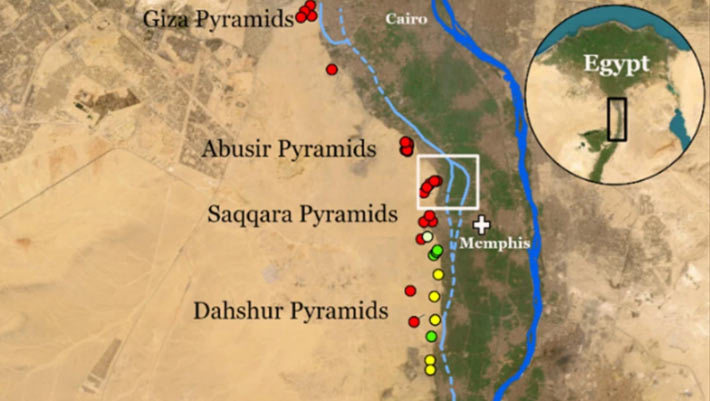Archaeologists in Egypt have identified segments of a 64-km-long extinct branch of the river Nile, which they name the Ahramat Branch, running at the foothills of the Western Desert Plateau, where the majority of the ancient Egyptian pyramids lie. Many of the pyramids, dating to the Old and Middle Kingdoms, have causeways that lead to the branch and terminate with Valley Temples which may have acted as river harbors along it in the past. The researchers suggest that the Ahramat Branch played a role in the monuments’ construction and that it was simultaneously active and used as a transportation waterway for workmen and building materials to the pyramids’ sites.
The water course of the ancient Ahramat Branch of the Nile. Image credit: Ghoneim et al., doi: 10.1038/s43247-024-01379-7.
The Egyptian pyramid fields between Giza and Lisht, built over a nearly 1,000-year period starting approximately 4,700 years ago, now sit on the edge of the inhospitable Western Desert, part of the Sahara.
Sedimentary evidence suggests that the Nile used to have a much higher discharge, with the river splitting into several branches in places.
Archaeologists have previously speculated that one of these branches may have flown by the pyramid fields, but this has not been confirmed.
Dr. Eman Ghoneim from the University of North Carolina Wilmington and colleagues studied satellite imagery to find the possible location of a former river branch running along the foothills of the Western Desert Plateau, very near to the pyramid fields.
The researchers then used geophysical surveys and sediment cores to confirm the presence of river sediments and former channels beneath the modern land surface, indicating the presence of a former branch, which they propose naming Ahramat (meaning ‘pyramids’ in Arabic).
They suggest that an increased build-up of windblown sand, linked to a major drought which began approximately 4,200 years ago, could be one of the reasons for the branch’s migration east and eventual silting up.
The discovery may explain why these pyramid fields were concentrated along this particular strip of desert near the ancient Egyptian capital of Memphis, as they would have been easily accessible via the river branch at the time they were built.
Additionally, the authors found that many of the pyramids had causeways which ended at the proposed riverbanks of the Ahramat Branch, which they suggest is evidence the river was used for transporting construction materials.
The findings reiterate the importance of the Nile as a highway and cultural artery for ancient Egyptians, and also highlight how human society has historically been affected by environmental change, according to the authors.
Future research to find more extinct Nile branches could help prioritize archaeological excavations along their banks and protect Egyptian cultural heritage.
“Revealing this extinct Nile branch can provide a more refined idea of where ancient settlements were possibly located in relation to it and prevent them from being lost to rapid urbanization,” the scientists said.
“This could improve the protection measures of Egyptian cultural heritage.”
“It is the hope that our findings can improve conservation measures and raise awareness of these sites for modern development planning.”
“By understanding the landscape of the Nile floodplain and its environmental history, archeologists will be better equipped to prioritize locations for fieldwork investigation and, consequently, raise awareness of these sites for conservation purposes and modern development planning.”
“Our finding has filled a much-needed knowledge gap related to the dominant waterscape in ancient Egypt, which could help inform and educate a wide array of global audiences about how earlier inhabitants were living and in what ways shifts in their landscape drove human activity in such an iconic region.”
The team’s paper was published in the journal Communications Earth & Environment.
_____
E. Ghoneim et al. 2024. The Egyptian pyramid chain was built along the now abandoned Ahramat Nile Branch. Commun Earth Environ 5, 233; doi: 10.1038/s43247-024-01379-7
>>> Read full article>>>
Copyright for syndicated content belongs to the linked Source : Sci-News.com – https://www.sci.news/archaeology/ahramat-branch-nile-12952.html
